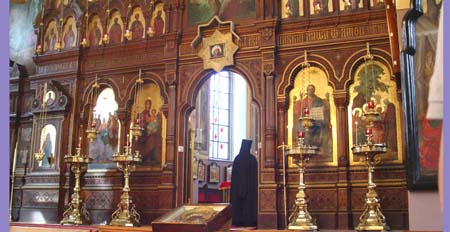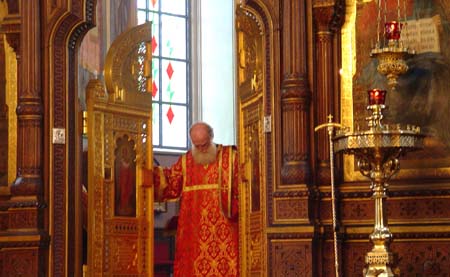







May 5, 2006 - Post No. 74

The Jewish Sabbath in Old Jerusalem is hard to miss. It begins at sundown on Friday, when a flash flood of orthodox and ultra-orthodox Jews engulfs Jaffa Gate and the streets leading down the hill to the Western Wall for the evening services there. In the wake of the flood, a remarkable quiet falls upon the western city, street traffic lightens, Israeli shops and services locked up tight for the next 24 hours.
Sabbath-Saturday begins for me with a phone call from Dean C. B. Baker (pictured, second from the right, above) who is in town with his wife Evelyn (pictured left) and a group from the Episcopal Cathedral in Memphis, Tennessee. The group makes up nearly half of the participants in the current Palestine of Jesus course at the St. George's College, the Anglican continuing education centre in Jerusalem. The two week course is offered about four times a year and is easily the best program I know for an informed and Spirit-based introduction to the Holy Lands.

C-B, Evelyn and I were last together in Jerusalem two years ago for the annual Conference of North American Deans, Spouses and Partners, a meeting of the deans of Anglican and Episcopal cathedrals in 2004 at St. George's. It is good to see them again and meet their "gang", including the Revd Jerry Crook (in red, above) who was a classmate of C-B's and possibly the first blind person to make his way through seminary and be ordained a priest in the Episcopal Church more than a few years ago. We get together for a delicious Sabbath lunch in the high vaulted basement of the Armenian Tavern -- apparently a former chapel -- a few steps from the monastery.
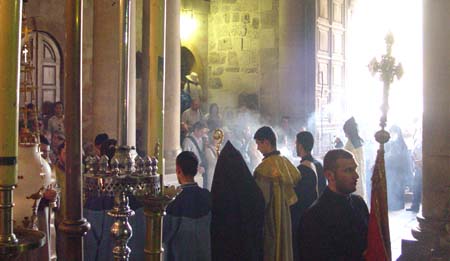
At 3 p.m. the great bell of the Cathedral of SS James calls us to gather at the main gate of the monastery for a march to the great Church of the Resurrection, the Holy Sepulchre. Nine times a year, the community holds a service of Saturday evening vespers at the basilica founded by Emperor Constantine about 1700 years ago. The nine services are apparently part of the status quo arrangement for the use of the basilica. (For more on the status quo arrangement, consult "Status Quo in the Virgin's Tomb.")
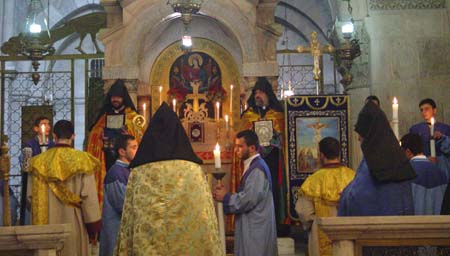
Tomorrow is "Green Sunday", the second Sunday after Easter, it commemorates the Universal Church founded in the Upper Room following the resurrection. It is also a Sunday with a youthful focus. Green in Armenian, as is sometimes the case in English, suggests youthfulness. Fr. Kegham tells me that to compliment a cook, one wishes that his or her hands stay green (youthful), or a pianist, that their fingers stay green (with the dexterity of youth.) So Green Sunday focuses on the youthful energy of Christian faith, the "news" of the Good News, or Gospel message.
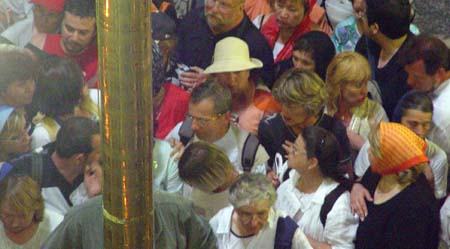
The pilgrims waiting for a turn to enter the Aedicule and pray in the Tomb of Jesus, is pressed to one side to make way as a group of acolytes and deacons comes down from the Armenian Gallery during the office of vespers to cense the entrance way to the Tomb. Click here for a movie (16MB) of the censing, as seen from the Armenian Gallery, high above.
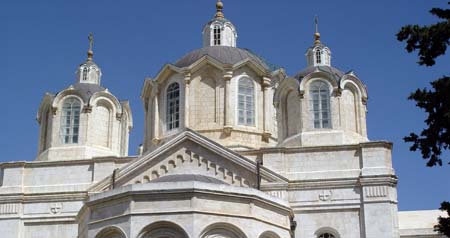
Following this first evensong for Green Sunday at the Church of the Resurrection, I walk over to the Russian Compound, outside the gates of Old Jerusalem, to attend a second office of vespers, this time at Holy Trinity Russian Orthodox Cathedral, pictured above.
The Russian Orthodox community in Jerusalem is represented by two
distinct groups , a division
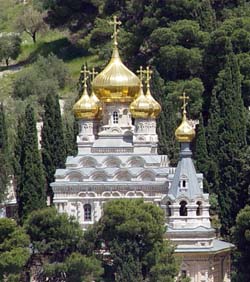 dating
back to the Bolshevik revolution and the collapse of Tsarist Russia. One
group, generally known here as the White Russians, was the church-in-exile during the Soviet period.
The White Russians have three sites in Jerusalem, the
most famous of which is the lovely convent church of St. Mary Magdalene on the
Mount of Olives with its golden domes (pictured, here).
dating
back to the Bolshevik revolution and the collapse of Tsarist Russia. One
group, generally known here as the White Russians, was the church-in-exile during the Soviet period.
The White Russians have three sites in Jerusalem, the
most famous of which is the lovely convent church of St. Mary Magdalene on the
Mount of Olives with its golden domes (pictured, here).
The second group of Russian Orthodox in Jerusalem is known as the Moscow Mission. This is the official outpost of the Moscow Patriarchate, which spent most of the 20th century under the thumb of the officially atheist Soviet Union.
The
stunning Holy Trinity Cathedral is all that remains of the once
extensive Russian Compound. Under the Soviet regime, the Patriarch of
Moscow was forced to sell off most of the buildings and property here; and the Israeli Government did all of the
buying with several government
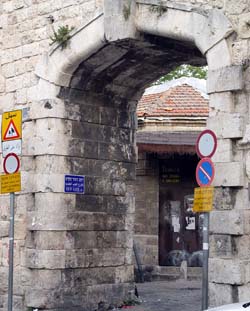 ministries
and services now based in what were formerly Russian convents,
monasteries, pilgrim hostels, a hospital and stables.
ministries
and services now based in what were formerly Russian convents,
monasteries, pilgrim hostels, a hospital and stables.
At one point, in the heyday of the 19th century, Jerusalem was so overwhelmed with the ebb and flow of Russian pilgrims throughout the year, that a new gateway, to ease the flow of pilgrim traffic, was cut in the wall -- called "New Gate" -- in the northeast corner of the old city, nearest the Russian Compound.
It is particularly encouraging to find a sizeable congregation in the Cathedral this evening, and to learn that the Russian Orthodox are enjoying a rebirth of sorts in the religious landscape of Jerusalem.
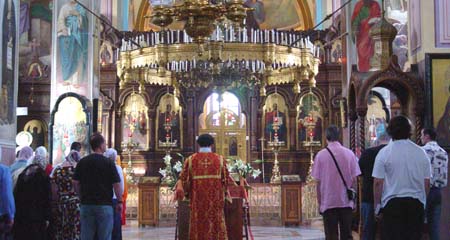
Much of this has to do with the Israeli open door policy easing the way for people of Jewish descent to immigrate to the country. There has been a steady flow of Russian immigration to Israel since the collapse of the Soviet regime, and most of the congregation tonight, I am told, is made up of newly arrived Russian Israelis who have some degree of Jewish ancestry, but who are Russian Orthodox in their religious affiliation. (One needs to remember that many, possibly most Israelis are in fact "secular" or non-practicing Jews -- i.e. Religious affiliation seems only incidental in determining status as an Israeli.)
Here are some pictures from this evening's service of vespers at Holy Trinity Cathedral in Jerusalem's Russian Compound. Click here for a short movie (9MB) from the service -- note the harmonious blend of voices in the small women's choir.
